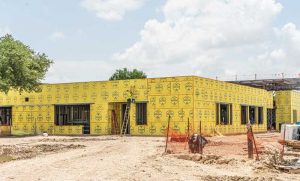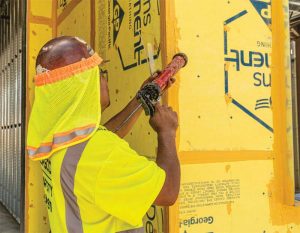
By John Chamberlin
Air barriers create airtightness and help protect against energy loss, water infiltration, and other hazards impacting the durability and resiliency of a building and the comfort and health of its occupants. Climate conditions, temperature, location, and intended use of a building all are factors to consider for the specification and selection of air barriers.
As airtightness in buildings is better understood and more closely monitored, newer technologies simplifying installation and quality control (QC) of construction also improve the likelihood of protecting a structure against air intrusion. This article examines the importance of air barriers in modern construction, the evolution of such technologies, the types of technologies available, installation tips and challenges, as well as several case studies.
Building Science Digest summarizes the challenges of airflow this way: “Airflow carries moisture that impacts a material’s long-term performance (serviceability) and structural integrity (durability), behavior in fire (spread of smoke), indoor air quality (distribution of pollutants and location of microbial reservoirs), and thermal energy.”1
Unchecked air movement can impact energy loss and efficiency, translating to wasted money on climate control. Further, airtightness has been implicated as a rationale for reducing the size of controls. This concept has not gained as much momentum as air’s role as a vehicle of water. Initially, vapor or moisture control generates greater interest, but air intrusion is often the gateway to vapor and water.
Air leakage also carries moisture which can impact a structure’s durability and resiliency. Air conveys vapor—which condenses into humidity and water once inside a building envelope. Humidity and water cause corrosion, damage to building materials, and mold and mildew growth; all these factors influence occupant health, an issue which has become top of mind for building owners and occupants as the pandemic reinforced the importance of air barriers in infection control.
In April 2021, The American Society of Heating, Refrigerating and Air-conditioning Engineers (ASHRAE) released a position document to offer guidance on mitigating disease transmission and readying buildings for post-pandemic operations. In it, ASHRAE offers insights on changes to building operations, including mechanical systems and humidity levels which can reduce airborne exposures and microorganism levels.
A subsequent article in The Construction Specifier on “The role of air barriers in disease transmission” expanded on these issues: “Air movement is typically considered to move significantly larger volumes of water vapor through or within the enclosure than vapor diffusion and is a concern from an infection control perspective, enclosure performance parameter, and operating costs associated with maintaining the elevated humidity.”2
Such health considerations demonstrate why air barriers are important, not just at the onset of a building’s construction, but throughout its lifecycle.

Evolution of air barrier technologies
Air barriers are a newer building component, emerging over the last 40 to 50 years—with the greatest results occurring in the last 20 years, as manufacturers, contractors, and others have become better and smarter.
Building wrap
Building wrap over sheathing has been used since the 1960s. When professionally installed, it is among the most economical air barriers. Installers must cut and fold the material properly around rough openings, and appropriately lap and tape everywhere to form a complete barrier.
Building wrap technology has advanced over the years, and specifiers now have several fabrics and accessories to match to their application. Among the considerations is the knowledge that wraps can rip or tear. Traditionally, wraps use fasteners to attach to buildings, creating opportunities for it to loosen against the building, especially in high-rises. Installers punch holes through the wrap which can provide air and water access to structural walls or allow weather elements to pull against the fasteners, permitting the wrap to tear away in strong storms and, at times, in mild breezes.




